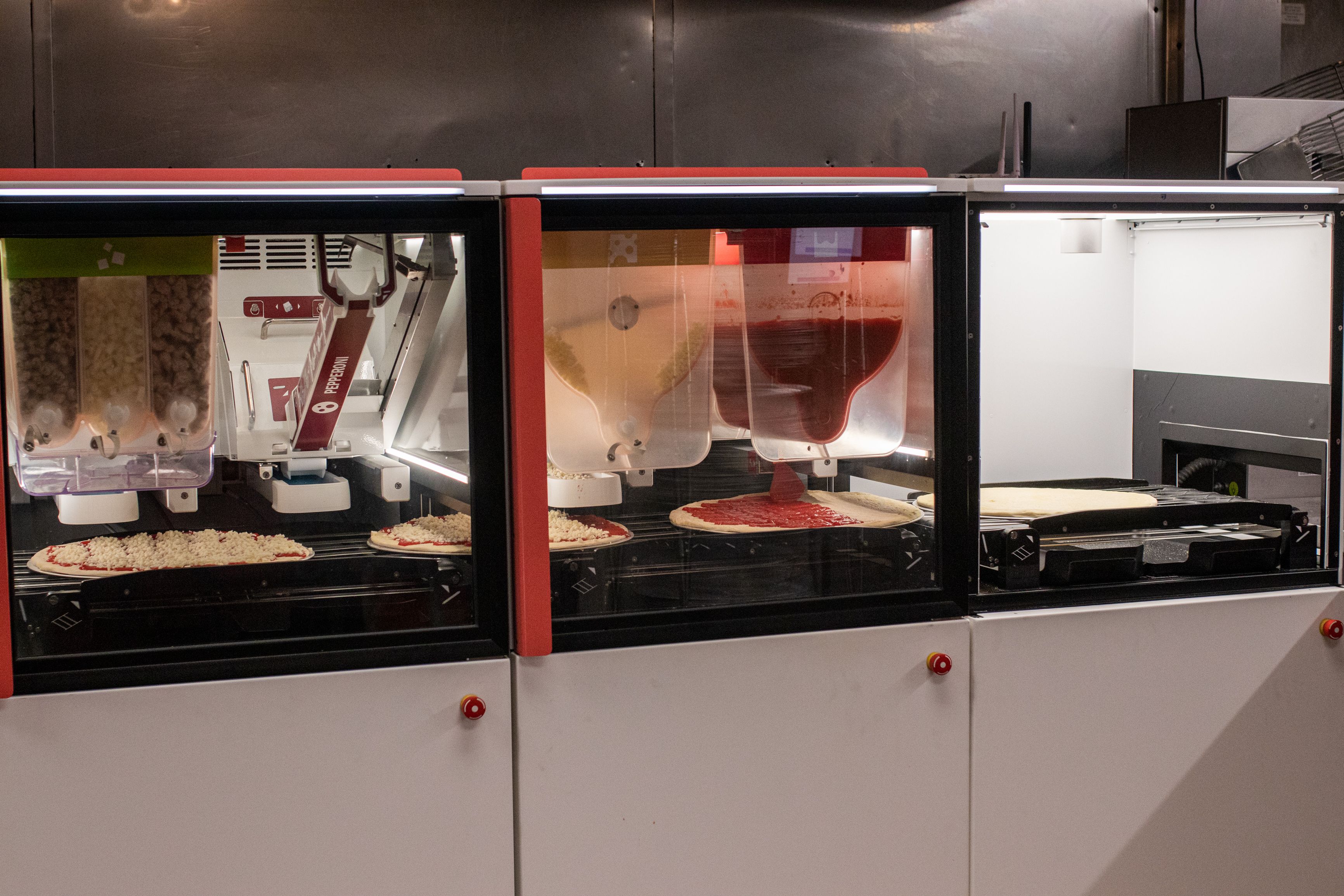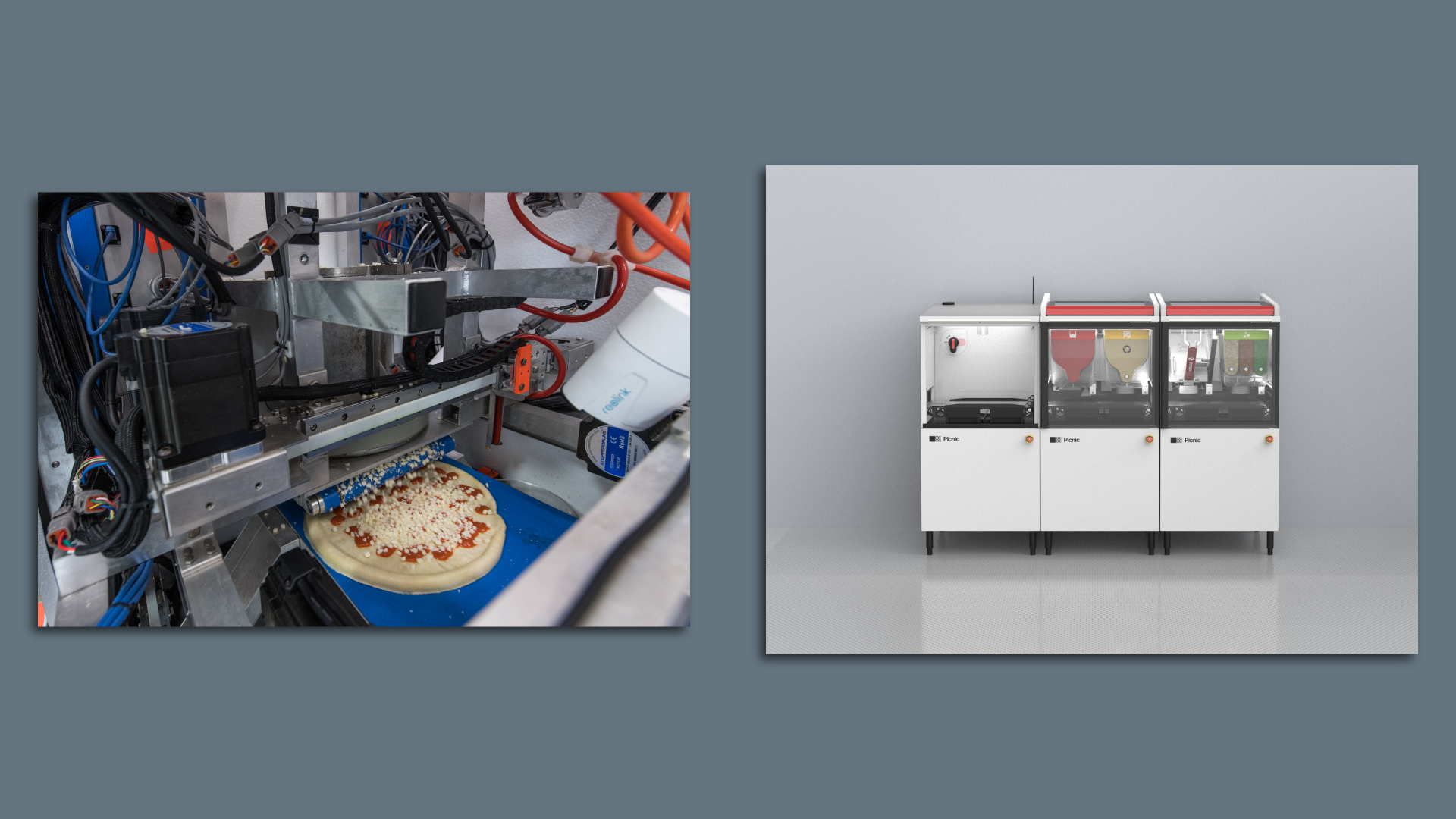Attack of the pizza-making robots

Artificial intelligence is taking the pizza business by storm, with a host of startups introducing machines that churn out pies faster and cheaper than humans.
Why it matters: While robots are making steady inroads in the restaurant industry overall — flipping burgers, frying chips, brewing coffee — pizza is the place where automation may make its earliest and most transformative mark.
Driving the news: Some of the brightest minds in engineering have turned their attention to pizza, building contraptions that can stretch dough, apply tomato sauce, and sprinkle cheese and toppings without human intervention.
- Stellar Pizza, founded by a former SpaceX rocket scientist, will open this month in Los Angeles with a fleet of trucks staffed by robotic pizza chefs (and human drivers).
- PizzaHQ in New Jersey has converted a traditional pizzeria into a robotic one, with plans to expand.
- Picnic Works is a tech company that leases the "Picnic Pizza Station," a modular assembly line that can make up to 100 pizzas an hour under the supervision of a single human attendant.
What they're saying: "Nobody in food service has enough workers," says Clayton Wood, CEO of Picnic Works, whose machines have been used by Domino's, SeaWorld and Chartwells, the school cafeteria vendor.
- Another problem robots solve? Consistency. "We're making a better pizza because it's made to the recipe," Wood tells Axios. "That actually turns out to be the #1 concern of pizza operators."
- Cheese is "the most expensive ingredient on the pizza" as well as "the most overtopped," with workers typically slapping on 40% too much — wasting money and glopping up the pies, Wood said.
- Plus, "if you think about someone placing 64 slices of pepperoni on a pizza, our system can do it very easily," he said.

Getting robots to make pizza is harder than it looks. Frozen pizzas are routinely assembled in a factory, but the process doesn't translate easily to a restaurant or food truck.
- "I've got a team of 30 SpaceX engineers designing the machinery, and it's actually really hard," Benson Tsai, Stellar Pizza's co-founder and CEO, tells Axios.
- His company's machines take pre-formed dough balls, stretch them out, and add sauce, cheese and toppings.

Between the lines: While some craftsmanship may be lost when robotic hands replace fleshly ones, there are plenty of advantages — like the ability to produce mass quantities at low prices.
- Stellar plans to sell 12-inch pies for about $10 — catering at first to hungry college students, and eventually parking in low-income neighborhoods to address the "food desert" problem, says Tsai.
- "We actually can make a fresher pizza because we're trying to shrink these giant pizza factories into little boxes," he said. "We're not trying to be the fancy Neapolitan — we are just a solid pizza choice here in Los Angeles."
PizzaHQ, which makes a 16-inch pie for $9.99, is targeting both the retail and institutional markets in northern New Jersey.
- "If you're having a party and you need 13 pizzas at your house, we can have it there quick," said co-founder Jason Udrija.
- "We are also establishing contracts with party venues like trampoline parks and daycare centers."
And there's the "pizzatainment" factor — it's fun to watch robots assemble pizzas, so some operators are playing that up.
- At PizzaHQ, "we have a TV that streams the robot, and all day long we're taking people back there giving tours," Udrija said.
- Placing a robotic pizza-maker on the concourse of a sports stadium or event venue would be a crowd-pleaser, Picnic Works suggests.
Yes, but: There's already been one noteworthy flop: Zume Pizza, which raised $375 million from SoftBank, shuttered its robot-crafted pie service in 2020 amid "complaints about cheese dripping everywhere [and] paltry little sauce on the pies," per Input magazine.
- And topping options are limited when a robot wears the apron. Aside from pepperoni, they "have to be granular, three-eighths inch, crumbled or diced," said Udrija, whose company leases its machinery from Picnic Works.
- "When you look at things like broccoli, it's tough to put in there," he said. "If you look at olives — olives are very wet, and it's hard. It doesn't work well with the machine."
The bottom line: While robot-made pies may one day be the norm, they'll likely face consumer skepticism for now.
- "One of the speed bumps is really going to be getting people used to pizza made by a robot," Udrija said. "There's a lot of pushback on, 'Hey, that product can't be good.'"
- But, he predicts: "20 years from now, all pizza is going to be made like this."